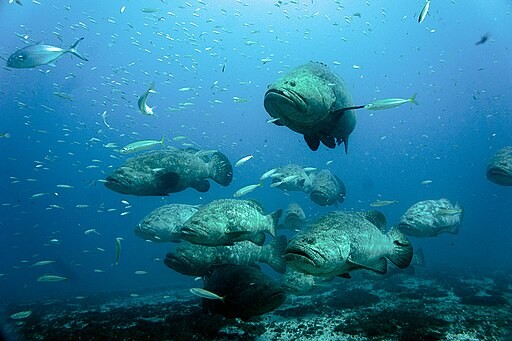In the shallow waters among the coral reefs in Florida, divers have long enjoyed the feeling of encountering massive groupers during their underwater adventures. These colossal fish are a sight to behold and a challenge to catch. Recent studies, however, reveal that these gentle giants are facing the threat of population decline due to overfishing.

Joy of Florida Divers
The goliath grouper (Epinephelus itajara) is the largest species of grouper in the Atlantic Ocean, weighing up to 800 pounds (360 kg). They mainly thrive in the shallow tropical waters among coral and artificial reefs from Florida to Brazil, the Caribbean, and the Gulf of Mexico.
The considerable grouper is considered an umbrella species, which means that other members of the ecosystems in their habitat depend on them to survive. They act as a top predator and maintain the health of the coral reef ecosystem where they live.
These creatures may appear cranky due to their naturally down-turned mouths and grumpy looks, but some allow human hands to brush themselves. It is like hovering next to a car-sized fish while being watched with oversized frowns and comically small eyes. As described by marine biologist Dr. James Locascio from the Mote Marine Laboratory, there is nowhere else that divers can have an up-close experience with a huge fish while exploring underwater. Because of this, the fish is worth a lot more alive than it is dead.
READ ALSO: Goliath Grouper Steals Fisherman's Catch, Drags Him Some Distances [Watch]
Facing the Threat of Extinction
In the 1980s, the fish species almost went extinct due to overfishing but was saved by conservation efforts. For over 30 years, the government banned fishing of goliath grouper.
However, in the past year, local authorities in Florida assumed that the fish population had recovered sufficiently. As a result, they allowed 200 of these animals to be caught and killed every year in state waters. Since the government allowed the fishing of groupers to resume, scientists have observed that the number of these animals has decreased.
Last September 10, Atlantic goliath grouper fish were seen swimming near Boynton Beach in Florida. Divers were amazed at the number of groupers that show up in this area, but as confirmed by locals, this animal's population has decreased in numbers in recent years. This trend was confirmed by a diving industry study, which reported that fewer and fewer of these fish were seen.
In 2022, researchers repeated a census of spawning sites conducted in 2013, and they discovered significantly fewer goliath groupers in five of the six locations being investigated. Unfortunately, goliath groupers grow slowly, live as long as 30 years, and take a long time to reproduce. According to Locascio, the International Union for Conservation of Nature has categorized the goliath grouper as a vulnerable species. Since the fish is an essential species for maintaining the balance of the ecosystem, conservationists do not want its population to decline.
RELATED ARTICLE: 117-Kilogram Bluefin Tuna Bigger Than 11-Year-Old Boy Captured After Over an Hour of Hauling; How Big Can These Fish Get?
Check out more news and information on Goliath Grouper in Science Times.



![Extinct Giant Salmon Had Tusk-Like Spikes Protruding Out of Its Snout That Can Easily Kill Shark, Other Large Marine Animals [Study]](https://1721181113.rsc.cdn77.org/data/thumbs/full/53304/89/56/50/40/extinct-giant-salmon-had-tusk-like-spikes-protruding-out-of-its-snout-that-can-easily-kill-shark-other-large-marine-animals-study.png)










